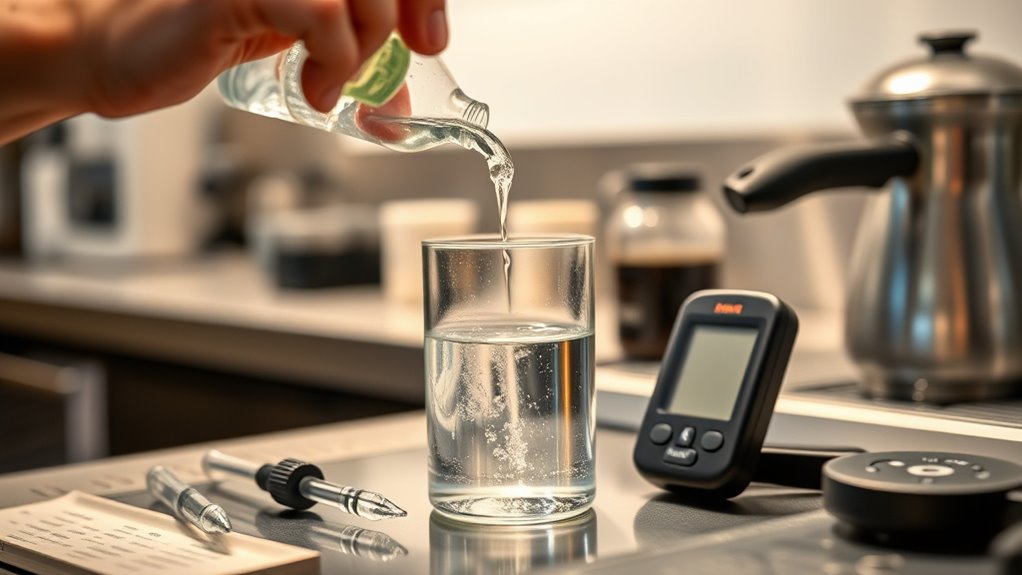To maintain perfect water hardness for coffee, regularly test your water’s mineral levels and pH using reliable kits or meters. Use a suitable water softening method like ion exchange or reverse osmosis, and keep your equipment well-maintained by descaling every 1-3 months, depending on hardness. Change filters proactively to prevent mineral buildup, and monitor your system’s performance. Following these steps helps guarantee consistent flavor and equipment longevity—stay with us to learn more about fine-tuning your water for excellent coffee.
Key Takeaways
- Regularly test water mineral levels and pH to monitor hardness and prevent over- or under-extraction.
- Use appropriate water softening systems (ion exchange, reverse osmosis) and maintain them per manufacturer guidelines.
- Schedule routine descaling of equipment every 1-3 months to prevent mineral buildup and ensure optimal performance.
- Replace water filters before their lifespan ends to maintain proper mineral content and prevent clogging.
- Keep detailed maintenance logs, including test results and filter changes, to ensure consistent water quality over time.
Understanding Water Hardness and Its Impact on Coffee
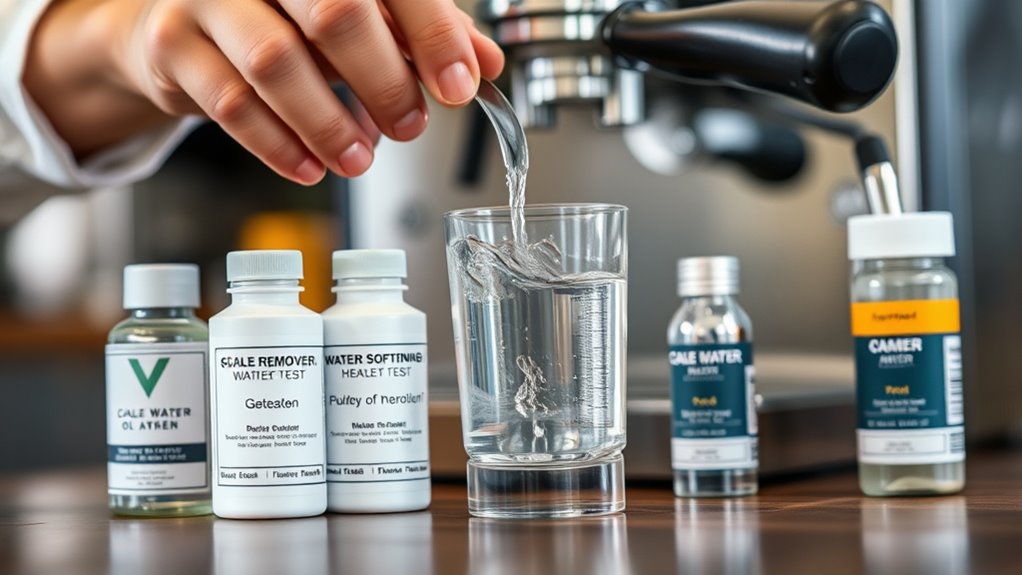
While water might seem like a simple ingredient, its hardness considerably affects your coffee’s flavor and quality. High calcium concentration in hard water can create a bitter or metallic taste, overshadowing the coffee’s natural flavors. It also influences the pH balance, making the water more alkaline, which can cause over-extraction and dull the coffee’s brightness. Conversely, soft water with low calcium levels might lead to under-extraction, resulting in a flat taste. Understanding how calcium impacts both flavor and pH balance helps you maintain the ideal water conditions for brewing. Properly balanced water ensures your coffee’s aroma, body, and acidity shine through, making every cup consistently enjoyable. Recognizing the role of water hardness is key to achieving a perfect brew. Additionally, maintaining water hardness levels through proper water treatment can prevent the buildup of mineral deposits in your brewing equipment, ensuring consistent quality over time.
Testing Your Water’s Hardness Levels
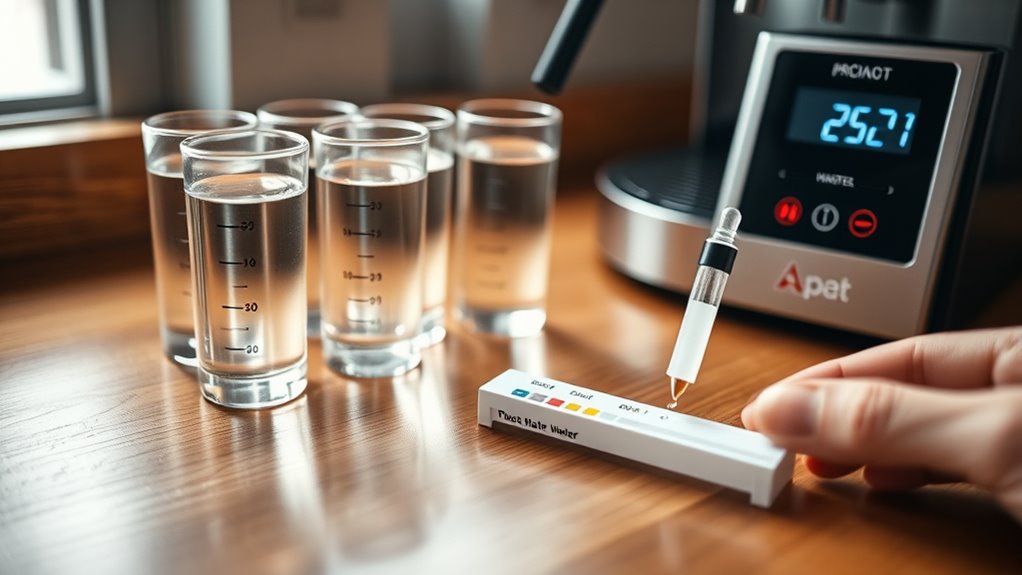
Knowing the water’s hardness level is the first step toward enhancing your coffee brewing process. To test it accurately, use a water testing kit or a digital tester designed for mineral content. These tools measure the hardness, giving you a clear picture of calcium and magnesium levels. Keep in mind, water’s pH balance also influences extraction and flavor, so test that as well. Proper testing ensures you understand your water’s mineral content and can adjust your routine accordingly. Regular checks prevent mineral buildup or insufficient hardness, which can compromise taste. By monitoring these levels consistently, you’ll maintain excellent water quality, ensuring your coffee always hits the perfect balance of flavor and extraction. Additionally, understanding water filtration methods can help you choose the best approach to improve your water quality for brewing.
Choosing the Right Water Softening Method
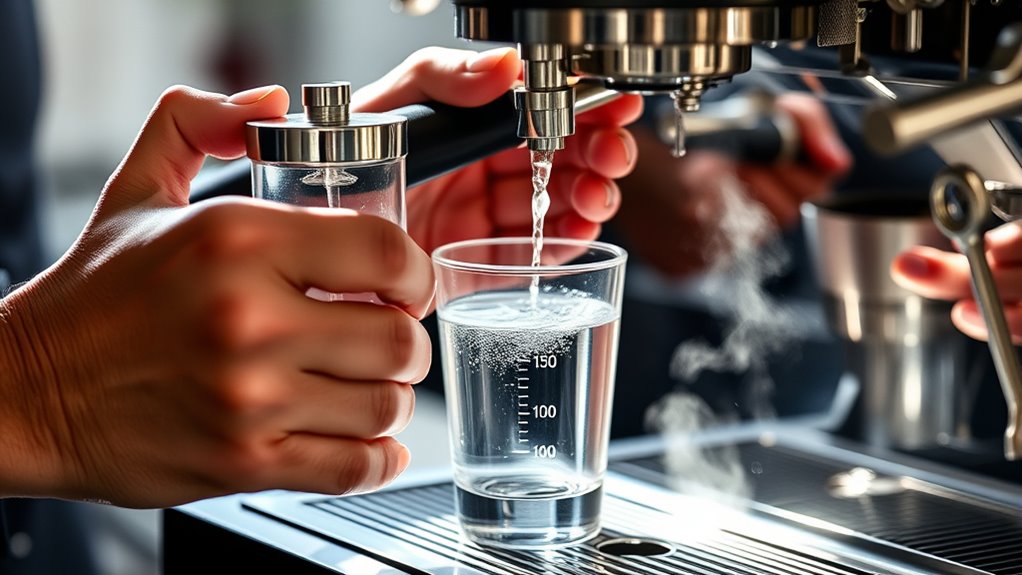
Selecting the appropriate water softening method is essential to achieve and maintain the ideal mineral balance for your coffee. Your choice depends on your water hardness level, budget, and preferences. Common water softening options include salt-based systems, which use ion exchange to remove calcium and magnesium. These systems are effective and popular but require salt refills. Alternatively, you can consider alternative softening methods like reverse osmosis or potassium-based systems, which might suit specific needs better.
| Water Softening Options | Benefits |
|---|---|
| Salt-based systems | Efficient, widely used, easy to manage |
| Reverse osmosis | Removes most impurities, pure water |
| Potassium systems | Eco-friendly, gentle on equipment |
Regularly Descaling Your Coffee Equipment
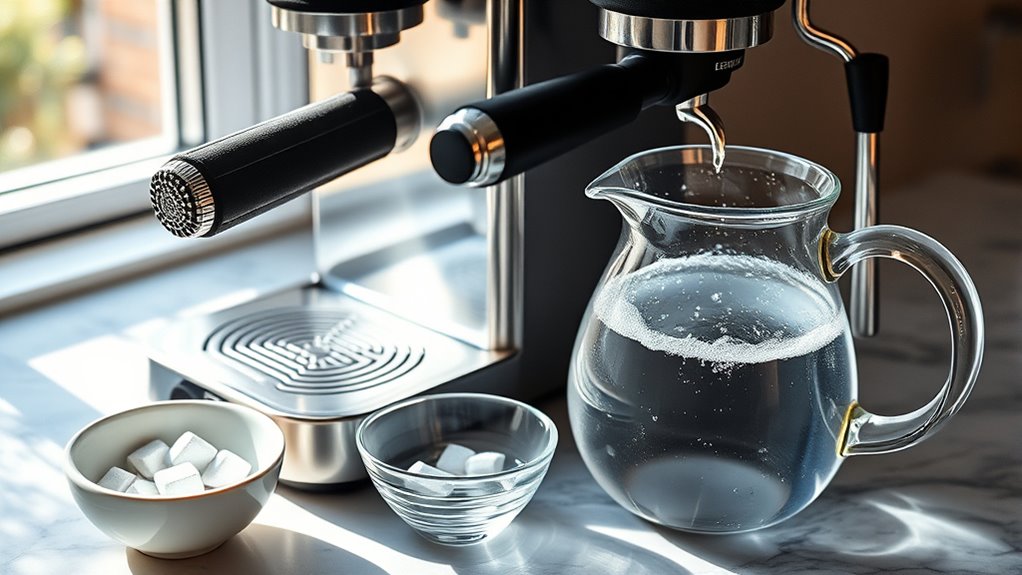
You’ll notice signs of lime buildup, like slow brewing or strange tastes, which signify it’s time to descale. Following recommended descaling frequency keeps your coffee equipment in top shape and prevents damage. Regular maintenance ensures your coffee stays flavorful and your machine lasts longer. Paying attention to water hardness levels can help you tailor your descaling routine for optimal performance.
Signs of Lime Buildup
Lime buildup is a common issue in coffee equipment that can substantially affect the taste and performance of your brew. You’ll notice mineral deposits and scale formation, which indicate buildup. Signs include slower water flow, inconsistent brewing temperatures, and gurgling sounds during operation. You might also see white or chalky stains around the machine’s interior or on the filters. Over time, these deposits can cause clogging, reduce efficiency, and impact flavor quality. Regularly checking for these signs helps prevent major issues. Keep an eye out for:
- Reduced water pressure
- Unusual noises during brewing
- Visible white residue or scale
- Longer brewing times
- Decreased output quality
Addressing these signals early guarantees your coffee stays flavorful and your equipment lasts longer. Incorporating healthy play routines like regular descaling and cleaning can help maintain optimal water hardness and prevent lime buildup.
Descaling Frequency Guidelines
To keep your coffee equipment functioning at its best and prevent mineral buildup, it’s essential to establish a regular descaling routine. How often you should descale depends on your water hardness and usage, but generally, aim every 1 to 3 months. Regular descaling promotes scale prevention and supports proper mineral balancing, ensuring your machine operates efficiently and consistently brews great coffee. If you notice a decline in performance or changes in water flow, it’s a sign to descale sooner. Use a descaling solution recommended by your manufacturer, and follow their guidelines closely. Consistent maintenance reduces the risk of lime buildup and prolongs your equipment’s lifespan. Staying on top of descaling fosters ideal water quality and preserves the perfect water hardness for your coffee.
Using Water Filters to Maintain Consistency
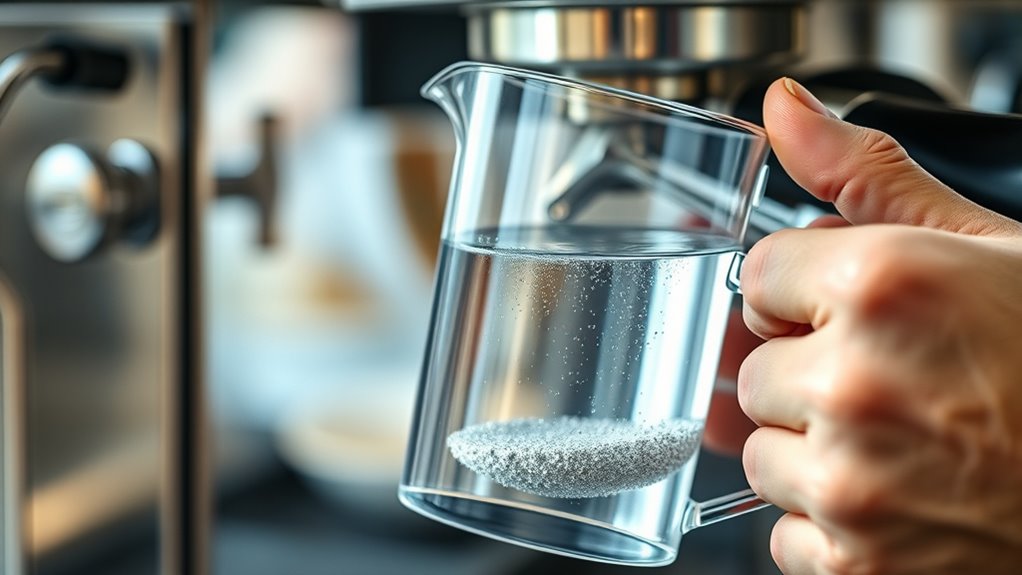
Using water filters is one of the most effective ways to guarantee your coffee consistently has the right water hardness. Proper filter use helps maintain mineral retention and prevents scale buildup, ensuring ideal flavor. To maximize effectiveness, keep track of the filter lifespan and replace it regularly. A well-maintained filter provides consistent mineral removal, reducing variability in water quality. Consider these key points:
Using water filters ensures consistent water mineral levels and prevents scale buildup for better coffee flavor.
- Replace filters before their recommended lifespan expires
- Choose filters designed for mineral retention control
- Regularly check for reduced water flow
- Avoid using filters with unclear or poor ratings
- Monitor water hardness levels for ongoing consistency
- Regularly testing your water helps ensure your filtration process maintains water hardness at optimal levels.
Adjusting Water Composition for Optimal Flavor
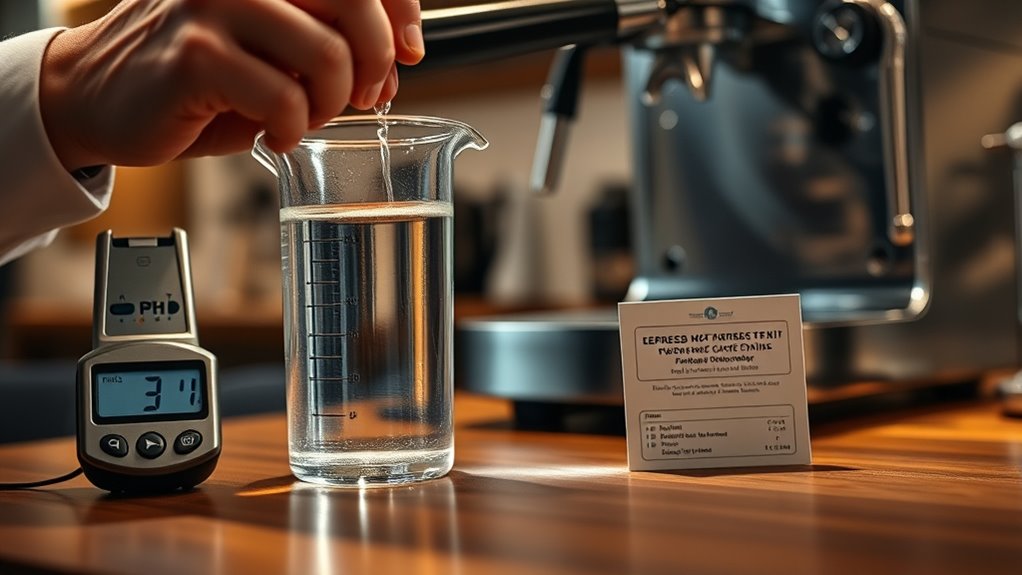
Adjusting the water composition is essential for revealing the full flavor potential of your coffee. You want the ideal pH balance and mineral content to enhance taste without overpowering notes. Too high or low pH can dull flavors, while improper mineral levels may cause bitterness or flatness. To fine-tune, consider adding mineral solutions or adjusting pH with safe agents. Use this guide:
| Factor | Effect on Coffee | Adjustment Method |
|---|---|---|
| pH balance | Affects acidity and brightness | Add pH stabilizers or acidifiers |
| Mineral content | Influences body and flavor depth | Use mineral blends or filtrates |
| Total hardness | Impacts extraction and clarity | Adjust with softened or mineralized water |
| Trace minerals | Contribute to complex flavor notes | Incorporate mineral concentrates |
Proper water composition balances the taste profile, ensuring every cup is ideal. Additionally, understanding the role of attention in the brewing process can help you maintain consistency and improve your skills over time.
Routine Maintenance and Monitoring Procedures
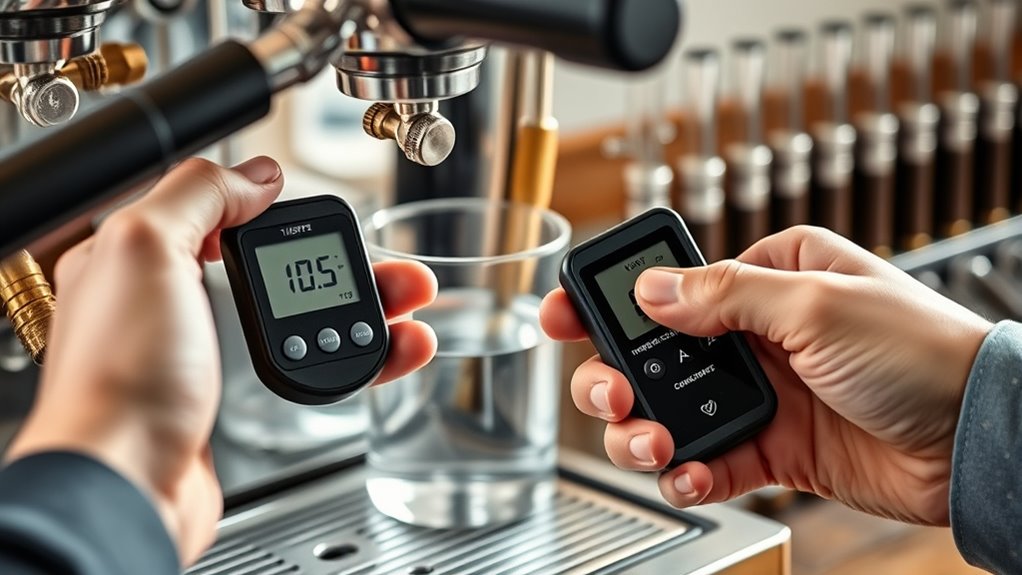
Maintaining ideal water quality requires regular monitoring and routine checks to prevent mineral buildup and guarantee consistent coffee flavor. You should consistently assess calcium deposits and track water pH levels to avoid issues that impact taste. Proper procedures include:
Regularly monitor water pH and calcium deposits to ensure optimal coffee flavor and prevent mineral buildup.
- Inspecting the water softener for calcium deposits
- Testing water pH weekly and adjusting if necessary
- Flushing mineral buildup from lines regularly
- Cleaning filters to prevent clogging
- Recording maintenance activities to track trends
- Incorporating fabric decorating markers to identify equipment or maintenance schedules for easy reference.
Troubleshooting Common Water Hardness Issues
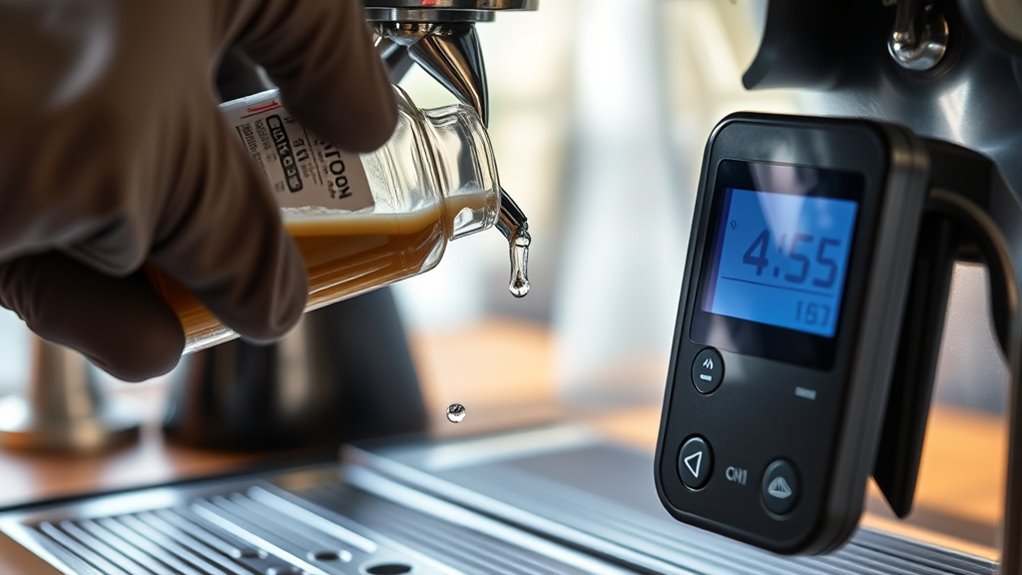
When water hardness levels become problematic, you may notice signs like mineral buildup, scale on equipment, or altered coffee flavor. These issues often stem from mineral imbalance, causing inefficient operation and poor taste. To troubleshoot, start by inspecting your equipment for visible scale buildup and cleaning it thoroughly with descaling agents. Check your water source or filtration system to ensure minerals are balanced correctly; too much calcium or magnesium can cause scale, while too little affects flavor. Adjust your water treatment processes if necessary, such as adding appropriate conditioners or filters. Regular monitoring helps catch problems early. Additionally, understanding water hardness levels through testing can help you better manage mineral content and prevent future issues. If issues persist, consider testing your water’s mineral content and consulting with a water treatment specialist to refine your maintenance routine and prevent future hardness problems.
Tips for Long-Term Water Quality Management

To keep your water quality consistent, you should regularly test its hardness levels. Make sure to change your filters on schedule to prevent buildup, and keep an eye on mineral content to avoid surprises. Additionally, using proper filter maintenance techniques will help extend the lifespan of your filtration system and ensure optimal water quality for your coffee over the long term.
Regular Water Testing
Regular water testing is essential to guarantee your coffee water remains at the ideal hardness level over time. Monitoring water quality helps you maintain proper mineral content and pH balance, ensuring optimal taste and equipment longevity. By testing regularly, you catch changes early, preventing scale buildup or flavor issues.
Consider these tips:
- Use test kits to measure water mineral content accurately
- Check pH levels, aiming for a neutral or slightly alkaline range
- Record results to track long-term trends
- Adjust your water treatment methods if mineral levels fluctuate
- Consult local water reports for regional water quality updates
Consistent testing empowers you to maintain perfect water conditions, ensuring your coffee always tastes its best.
Consistent Filter Changes
Consistent filter changes are essential for maintaining ideal water quality over the long term. By replacing your filter before it reaches the end of its lifespan, you help preserve the proper mineral balance necessary for great coffee. An old or clogged filter can allow mineral build-up or uneven filtration, which impacts water hardness and flavor. Checking your filter’s recommended lifespan ensures you don’t wait too long to change it. Regular filter replacements also prevent sediment and impurities from reaching your coffee machine, reducing maintenance issues and extending its lifespan. Keep track of your filter’s usage and replace it proactively. Doing so guarantees consistent water quality, preserves excellent mineral levels, and helps you brew the perfect cup every time.
Monitoring Mineral Levels
Monitoring mineral levels is crucial for maintaining ideal water hardness over time. Regularly checking calcium levels and mineral saturation ensures your water remains perfect for coffee brewing. By staying on top of these metrics, you prevent issues like scale buildup or flavor inconsistencies. Here are key tips for long-term water quality management:
- Use test strips or digital meters to measure calcium levels weekly
- Track mineral saturation to avoid over-concentration
- Adjust your filtration system based on mineral readings
- Regularly clean appliances to prevent mineral deposits
- Keep a log of mineral levels to identify trends and plan maintenance
Consistent monitoring helps you catch changes early, ensuring your coffee always brews with suitable water conditions. Proper oversight minimizes both scale issues and flavor disruptions, preserving your coffee’s quality.
Frequently Asked Questions
Can Mineral Content in Water Affect Coffee Taste Differently?
Yes, mineral content in water can substantially affect your coffee’s taste. Water mineralization influences flavor extraction, making your brew more or less vibrant. High mineral levels can add a metallic or bitter note, while balanced mineralization enhances sweetness and aroma. When minerals are just right, they optimize extraction, resulting in a richer, smoother coffee experience. Adjusting water mineralization ensures your coffee tastes consistent and delightful every time.
How Often Should I Replace Water Filters for Optimal Results?
You should replace your water filter according to the filter lifespan specified by the manufacturer, typically every 2 to 3 months. Following a consistent replacement schedule guarantees peak water quality, preventing mineral buildup and maintaining the best taste for your coffee. Keep an eye on the filter’s indicator if it has one, and don’t wait too long—neglecting timely changes can compromise your coffee’s flavor and your machine’s performance.
Are There Specific Water Softening Methods Better for Espresso Machines?
You should choose softening techniques that maintain ideal water pH levels for espresso machines. Ion exchange filters are popular because they effectively reduce mineral content without overly altering pH. Reverse osmosis systems also work well, but you might need to re-mineralize the water afterward. Always test your water’s pH regularly, ensuring it stays within the ideal range for espresso brewing, around 6.5 to 7.5.
What Signs Indicate My Coffee Machine Needs Descaling Sooner?
You might notice scale buildup and brewing inconsistencies sooner if your coffee starts to taste off or if your machine takes longer to heat. Investigating the theory that mineral deposits affect performance shows these signs are true. Regularly check for visible white or chalky deposits and watch for uneven extraction. These indicators suggest it’s time to descale, preventing further damage and ensuring your coffee remains consistently delicious.
How Does Water Temperature Influence Mineral Buildup in Equipment?
Higher water temperatures accelerate mineral buildup in your coffee equipment because heat causes minerals like calcium and magnesium to precipitate more quickly. When water reaches boiling point or stays hot for extended periods, it promotes scale formation inside pipes and boilers. To minimize mineral buildup, avoid using excessively hot water and regularly descale your machine, especially if you notice a decrease in performance or taste issues. Proper temperature control helps maintain cleaner equipment longer.
Conclusion
By mastering your water’s hardness, you hold the secret to coffee perfection—it’s like having a magic wand that transforms every cup into a masterpiece. Neglecting these routines could turn your brew into a bitter disaster or a bland disaster zone. So, stay vigilant, test regularly, and keep your equipment sparkling. When you do, you’ll uncover flavors so rich and vibrant, they’ll make your taste buds sing like never before—coffee greatness is just a maintenance routine away!
